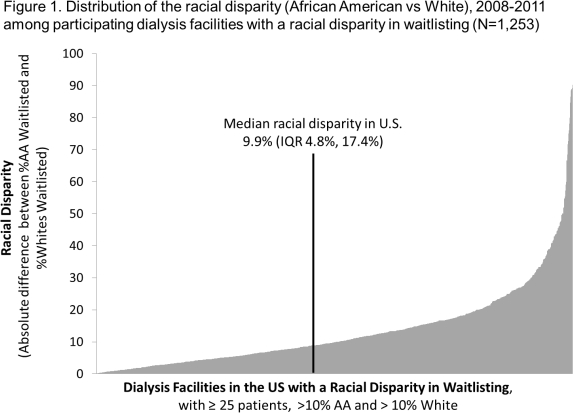U.S. Dialysis Facility Characteristics Associated with Racial Disparities in Access to the Kidney Deceased Donor Transplant Waiting List.
Emory University, Atlanta.
Meeting: 2016 American Transplant Congress
Abstract number: 42
Keywords: Kidney, Kidney transplantation, Public policy
Session Information
Session Name: Concurrent Session: Kidney Transplantation: Outcomes, Matching and Marginal Donors
Session Type: Concurrent Session
Date: Sunday, June 12, 2016
Session Time: 2:30pm-4:00pm
 Presentation Time: 2:42pm-2:54pm
Presentation Time: 2:42pm-2:54pm
Location: Ballroom B
BACKGROUND Dialysis facility characteristics have been significantly associated with variation in U.S. transplant rates but facility characteristics associated with disparities in access to the kidney deceased donor transplant waiting remain unknown.
METHODS Data on percentage of patients aged <70 waitlisted for kidney transplantation and other facility characteristics were obtained from the Dialysis Facility Report (2008-2011). All U.S. dialysis facilities with 25+ patients and ≥10% AA and ≥10% white patients were included. Facilities were categorized with a racial disparity if the %AA waitlisted was less than the %white waitlisted. The magnitude of racial disparity was defined as the difference between the percentage of white dialysis patients waitlisted vs percentage of AA ESRD patients waitlisted. Logistic regression determined the facility characteristics associated with racial disparity in waitlisting.
RESULTS Among 2,637 U.S. dialysis facilities,1,253 (47.5%) dialysis facilities had a racial disparity in waitlisting; 111 facilities had 0% AAs waitlisted. Among U.S. facilities with a waitlist disparity, the median racial disparity was a 9.9% difference (IQR 4.8%, 17.4%) and there was substantial variation in this disparity  . With adjustment, each 10 patient increase (OR=1.1; 95% CI 1.0, 1.1) and each 25% increase in %AA (OR=1.1; 95% CI 0.9, 1.2), was associated with a 10% increased risk of waitlisting disparity. Each 10% increase (OR=0.9; 95% CI 0.87, 0.99) in percentage of patients with no nephrology care was associated with a 7% decrease in risk for waitlist disparity. Facilities with 100% of their patients on hemodialysis, vs. <100%, were 40% (OR=1.4; 95% CI 1.0, 2.0) more likely to have a racial disparity in waitlisting.
. With adjustment, each 10 patient increase (OR=1.1; 95% CI 1.0, 1.1) and each 25% increase in %AA (OR=1.1; 95% CI 0.9, 1.2), was associated with a 10% increased risk of waitlisting disparity. Each 10% increase (OR=0.9; 95% CI 0.87, 0.99) in percentage of patients with no nephrology care was associated with a 7% decrease in risk for waitlist disparity. Facilities with 100% of their patients on hemodialysis, vs. <100%, were 40% (OR=1.4; 95% CI 1.0, 2.0) more likely to have a racial disparity in waitlisting.
CONCLUSION Racial disparities in access to the kidney deceased donor transplant waiting list widely vary across the U.S. Larger, HD-only facilities with greater proportions of AA patients may have greater likelihood of disparity and could make potential targets for interventions.
CITATION INFORMATION: Gander J, Plantinga L, Paul S, Pastan S, Patzer R. U.S. Dialysis Facility Characteristics Associated with Racial Disparities in Access to the Kidney Deceased Donor Transplant Waiting List. Am J Transplant. 2016;16 (suppl 3).
To cite this abstract in AMA style:
Gander J, Plantinga L, Paul S, Pastan S, Patzer R. U.S. Dialysis Facility Characteristics Associated with Racial Disparities in Access to the Kidney Deceased Donor Transplant Waiting List. [abstract]. Am J Transplant. 2016; 16 (suppl 3). https://atcmeetingabstracts.com/abstract/u-s-dialysis-facility-characteristics-associated-with-racial-disparities-in-access-to-the-kidney-deceased-donor-transplant-waiting-list/. Accessed December 15, 2025.« Back to 2016 American Transplant Congress
